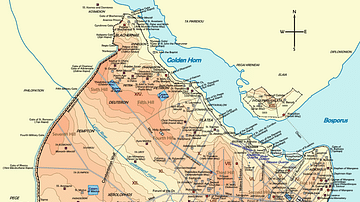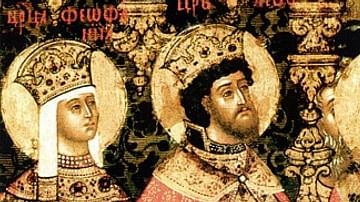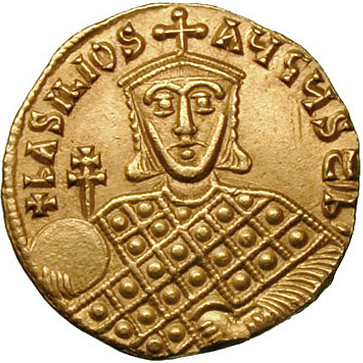
Basil I was emperor of the Byzantine Empire from 867 to 886 CE and he founded the "Macedonian" dynasty which lasted for over 200 years. Basil was an Armenian from a humble background who had risen to become the second most powerful man in the realm. When he outrageously killed his benefactor and emperor, Michael III, he became number one in Constantinople and oversaw a golden period in Byzantine history. Losing his throne in the same way he had gained it, Basil was succeeded by his son Leo VI in 886 CE.
Co-emperor with Michael III
Michael III, also known as “Michael the Drunkard” by his detractors, was emperor of the Byzantine Empire from 842 to 867 CE. His reign saw many military successes, especially in the east but the young ruler, later known for his love of wine and song, made the fateful decision to befriend and promote a certain uncouth Armenian known as Basil the Macedonian. Basil had probably never set foot in Macedon and his epithet seems to have derived from him having spent time with a group of prisoners of that region when he was captured by Krum, king of the Bulgars. He was from a peasant Armenian family who had relocated to Thrace but his life would be a classic rags-to-riches story.
Leaving his family, Basil sought his fortune in the metropolis of Constantinople and he certainly found it. Known as a talented wrestler and horseman, Basil's skills led him to be put in charge of the imperial stables - Michael was a keen charioteer - and from there, when spotted by the emperor, he was made Guardian of the Imperial Bedroom (parakoimomenos). In his new role Basil removed, by any means he saw fit, the enemies of the emperor. By far the biggest name to be targeted was Bardas, uncle of Michael and the chief minister responsible for much of the empire's success. Bardas was rightly suspicious of the Armenian interloper but was reassured by a solemn promise from both Basil and Michael that they had no ill-feeling towards him, an oath said to have been signed in the blood of Jesus Christ - a relic housed in the Church of St. Sophia. Basil, being illiterate, could only mark the document with an X.
Despite the promises, Basil went right on ahead and personally murdered Bardas in 865 CE. The dead general had clearly not heeded his own warning to Michael years earlier that the Armenian was a “lion who would devour them all” (Brownworth, 165). The murder was indicative of the lengths Basil would go to feed his ambition: no one was to stand in his way.
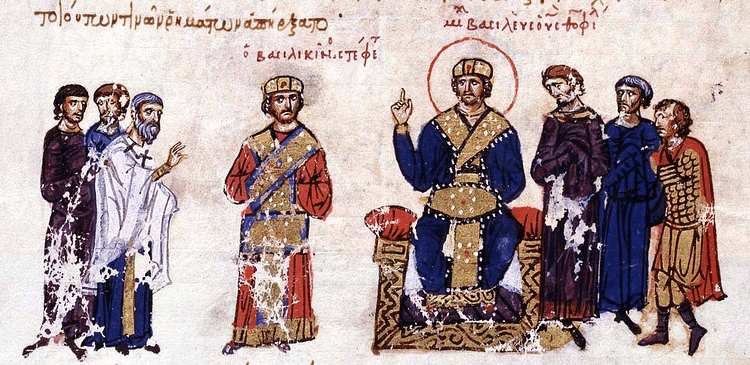
Michael and Basil had a complex, ill-defined and much-debated relationship with Eudokia Ingerina, Michael's mistress - Basil actually marrying her, but this may have been a ruse on Michael's part to have his mistress close at hand in the palace. What is even more extraordinary, in 866 CE Michael made Basil co-emperor (basileus) in a lavish ceremony in the Church of St. Sophia, likely as thanks for removing Bardas, now officially recorded as a traitor. Michael had the following statement read out at the coronation:
It is my will that Basil, the High Chamberlain, who is loyal to me, who has delivered me from my enemy and who holds me in great affection, should be the guardian and manager of my Empire and should be proclaimed by all as basilieus. (Norwich, 150)
Sixteen months later the Armenian assassin would turn out to be just as treacherous to his sponsor, though, and he had Michael brutally murdered in his bedchamber in 867 CE, claiming the throne for himself alone under the title Basil I.
Sole Emperor
In the first year of his reign Basil reinstated Ignatios as the Patriarch of Constantinople (bishop). This decision improved relations with the papacy who had protested vehemently at the appointment of Photios for that position, then a layman, by Michael III. Basil was probably motivated by the need for Papal military support in Italy where Byzantine armies were busy battling the Arabs. Certainly, there was no personal issue with Photios who Basil was happy to employ as his children's tutor. Photios, in any case, got his old job back as bishop when Ignatios died in 877 CE, this time endorsed by Pope John VIII in a show of reconciliation with the Eastern Church. Photios did much to promote the study of Classical Greek and Roman literature, and he wrote some of the earliest surviving book reviews.
Ultimately, Basil did reconquer southern Italy, thanks to help from the Franks, although a notable fail was the loss of Syracuse in Sicily in 878 CE. Early in his reign Basil had seen the loss of Malta to the Arabs but a massive investment in modernising and strengthening the Byzantine navy paid dividends. Basil could call on the gifted admiral Nicetus Ooryphas, who gave his new ruler a victory against the infamous Cretan pirates, catching them on the hop by crossing the narrow isthmus of Corinth. Successes against the crumbling Arab caliphate empire were enjoyed in Cyprus, mainland Greece, and Dalmatia. Basil's armies won victories against the Paulicians in Asia Minor, too, sacking their capital at Tephrike, and moved deeper into central Asia along the Euphrates River.
Back home, Basil got on with the task of governing and, if the official records are to be believed, he was especially keen to improve the lot of the poor, promote the arts in Constantinople and generally make his capital look worthy of its status. He is credited with building the Nea Ekklesia (“New Church”) on the grounds of the royal palace in 880 CE. The church was magnificent with five gilded domes, exotic marble on the inside, silver decorations on the outside, two fine fountains and bells shipped in from Venice. Unfortunately for modern tourists, the church blew up in 1453 CE after the Turks had been using it as a gunpowder store. Even more sumptuous was Basil's new palace, the Kainourgion. It had fine mosaic flooring depicting giant eagles, wall-paintings, eight columns of green stone and eight of onychite (a type of marble), and a throne room with a ceiling made from glass mosaic and solid gold filling. There was a half-dome at one end of this room with a giant painting of Basil and adoring generals presenting the emperor with a symbol from each city that his armies had conquered.
Public buildings, monuments and walls across the capital were also given a much-needed revamp after years of neglect and damage by earthquakes, notably the Church of St. Sophia which was in serious danger of toppling after a quake in 869 CE. Sadly, none of Basil's achievements in making Constantinople one of the great city's of the world still stands today.
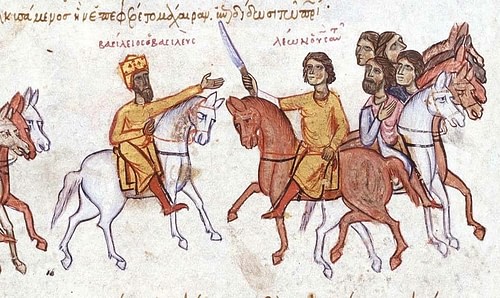
Perhaps more useful to his people than architectural embellishments was Basil's determination to completely overhaul Byzantine law. During his reign a vast number of new laws were introduced in the greatest flurry of legal activity since the reign of Justinian (r. 527-565 CE). Indeed, Justinian's code was the primary target of Basil's updated revisions which also ordered laws by subject for easier future reference. Much of the emperor's new legislation - written in Greek and not Latin, as before, and known collectively as the Basilika - was ultimately encapsulated in two handbooks, the Procheiron and Epanagogue, designed to be of use to judges and lawyers.
Basil & Leo
Basil had two heirs: Constantine, the eldest, who was from his first marriage and Leo, who was from his marriage with Eudokia. It had become customary for emperors to crown their son and chosen heir as co-emperor, even when still a child but Basil went one better and crowned both his sons, Constantine in 869 CE and Leo in 870 CE. To Basil's great distress Constantine died prematurely of unknown causes in September 879 CE, a blow from which the emperor never fully recovered and which caused him to largely withdraw from public life.
Basil's relationship with his second-choice heir was a troubled one. Leo, forced to marry a girl of his father's choosing - the pious Theophano - had acquired himself a mistress named Zoe Zautsina whom, naturally, his father disapproved of. Basil tried, unsuccessfully, to break the relationship by banishing the girl and making his son a virtual prisoner in a wing of the royal palace. Beaten, imprisoned and threatened with blinding, it is perhaps no wonder that Leo might have borne a grudge which would one day prove fatal for his father.
Death & Legacy
Basil died in 886 CE. The cause, according to official records, was a hunting accident. The tale was a tall one involving the 74-year old emperor being dragged an improbable distance through the woods by a stag and then rescued by a group led by Zoe's father. It seems much more likely that Leo arranged for his father to be helped off his throne. It was a final irony and a sweet revenge from beyond the grave by Michael III that Basil's successor would be Leo, widely rumoured to actually have been the son of Michael. It is, perhaps, significant that one of the first acts of the new 19-year old emperor, now Leo VI (r. 886-912 CE), was to exhume Michael III's body from his nondescript grave and entomb him in a fine marble sarcophagus in the Church of the Holy Apostles.
Whatever the exact lineage, Basil's successors, the “Macedonian” emperors, made special efforts to whitewash the more unsavoury elements of the dynastic founder's reign. Basil's grandson, Constantine VII (r. 913-959 CE), was especially keen not to have any tarnish spread to his own image. Consequently, he wrote the biographical Vita Basilii which became the accepted historical record of Basil's life and achievements where the one-time wrestler is presented as one of the great emperors of Byzantium.
This article was made possible with generous support from the National Association for Armenian Studies and Research and the Knights of Vartan Fund for Armenian Studies.



